|
|
|
Sort Order |
|
|
|
Items / Page
|
|
|
|
|
|
|
| Srl | Item |
| 1 |
ID:
123224
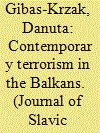

|
|
|
|
|
| Publication |
2013.
|
| Summary/Abstract |
The aim of this article is to examine the terrorism in the Balkans. Contemporary Islamic terrorism in the Balkans is caused by the increase of influences of Muslim fundamentalists, especially in Bosnia and Herzegovina. The origins of Islamic terrorism are connected with radical trend of this religion, which became popular in the society in the period of socialist Yugoslavia. However, this trend could be widespread on a larger scale only when Mujahideen came to Bosnia and Herzegovina to take part in the civil war. In Bosnia and Herzegovina, it was the religious fanatics who mainly participated in the fighting. Many of them were the members of terroristic organizations, such as Al-Qaeda, Hezbollah, Hamas, and Al-Gama'a al-Islamiyya. A considerable number of 'Warriors of Allah' remained on the territory of Bosnia and Herzegovina after the end of the civil war, thus, contributing to the development of the terrorist network connected with radical factions of Islam. The author emphasizes that is essential to take complex actions that aim to fight this threat by international cooperation of special services and the police as a part of the European Union (UE) mission. It is even more important since West Balkans actively participate in the UE and North Atlantic Treaty Organization (NATO) integration processes.
|
|
|
|
|
|
|
|
|
|
|
|
|
|
|
|
| 2 |
ID:
123226


|
|
|
|
|
| Publication |
2013.
|
| Summary/Abstract |
The Kingdom of Hungary had to face a post-war clutter in 1918-1919. Each center of power tried to establish a kind of armed forces and police in this period. For a long time, Hungary did not have a general staff. Therefore, the Ministry of Defense had an office which worked like general staff, severely 'sub rosa'. Officially the Hungarian General Staff and the branch for intelligence and/or counterintelligence were established in 1938. It had good relationship with its German counterpart and included the Hungarian entity for political investigations. The officials knew which German officer had a Hungarian "connection" and who this person was. It is only a historical quaintness that soldiers or Reichssicherheitshauptamt (Reich Security Main Office [RSHA]) officers and Hungarian police officers joined Office of Strategic Services (OSS) after World War II.
|
|
|
|
|
|
|
|
|
|
|
|
|
|
|
|
| 3 |
ID:
123223
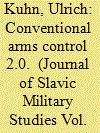

|
|
|
|
|
| Publication |
2013.
|
| Summary/Abstract |
For more than a decade Europe's once unique arms control acquis is in decline. This pertains foremost to conventional arms control. An assessment of current political North Atlantic Treaty Organization (NATO)-Russia problems and military insecurities on the continent shows that a modern approach to conventional arms control could positively contribute to security and stability. In times of financial austerity, a new framework has to focus on mutual military reassurances, transparency, conflict prevention, and the links to nuclear arms control. To achieve such a goal, U.S. leadership, as well as Europeanization of the Reset policy, is needed.
|
|
|
|
|
|
|
|
|
|
|
|
|
|
|
|
| 4 |
ID:
123228
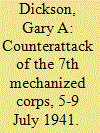

|
|
|
|
|
| Publication |
2013.
|
| Summary/Abstract |
The war between Germany and the Soviet Union witnessed some of the largest tank battles in history. Most accounts of the Russo-German war label the battle of Kursk, specifically the fighting around the village of Prokhorovka on 12 July 1943, as the largest tank battle in history. However, since the fall of the Soviet Union, more details have come out regarding other, lesser known, battles that involved even more tanks. One of these engagements was the counterattack by the Red Army's 20th Army using two of the newly created mechanized corps. During the period 5-9 July 1941, the Soviet 5th and 7th mechanized corps launched a counterattack with over 1,000 tanks against elements of two German mobile corps around the village of Senno in what is now Belarus. Almost unknown in the West and virtually ignored in the Soviet Union, study of this battle sheds light on the condition of the Red Army in the first weeks of the war and on the lessons that influenced the future development of large-scale armored formations in the Red Army.
|
|
|
|
|
|
|
|
|
|
|
|
|
|
|
|
| 5 |
ID:
123221
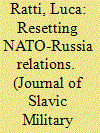

|
|
|
|
|
| Publication |
2013.
|
| Summary/Abstract |
This article provides an analysis of the 'reset' policy toward Russia, which was inaugurated in 2008 by the Obama administration and soon embraced by the North Atlantic Treaty Organization (NATO). It argues that, rather than being prompted by domestic dynamics in the United States, the 'reset' was a response to systemic pressures. More specifically, the West's relative decline on the international system, the retrenchment of expeditionary NATO, and the rise of potentially revisionist powers. Although prompting an improvement in the relationship, these pressures failed to bring about Russia's full integration into the post-Cold War Western international settlement. In the immediate aftermath of the 2008 Russian-Georgian War, NATO's relations with Moscow experienced an initial revitalization through a resumption of the works of the NATO-Russia Council (NRC), the signing of a New Start Treaty between the United States and Russia in 2010, and an expansion of supply lines to Afghanistan through Russian territory. However, there was no real incentive for both sides to truly 'reset' the relationship. The alliance never treated Russia equally, preferring instead to dictate conditions. Any discussion of Russian-NATO relations was couched in this context; the 'reset' was also conceived as a small gift to Moscow. For its part, the Kremlin never accepted a junior partner status, making it clear that its preferred option remains the alliance's dissolution and the creation of a different, new pan-European organization that would incorporate the Russian Federation as a full member. The article concludes that, despite the mixed achievements of the 'reset', the alliance retains a systemic incentive to seek durable cooperation with Russia.
|
|
|
|
|
|
|
|
|
|
|
|
|
|
|
|
| 6 |
ID:
123222


|
|
|
|
|
| Publication |
2013.
|
| Summary/Abstract |
Science and technology can play a crucial role in the long-term for the modernization of Russia and the armed forces, and many government initiatives have been approved but their implementation can be questioned. Russia has a strong science base into which it invests substantial funds, but that only to a limited extent generates competitive innovative products and services. The government still hopes the defense sector can be the driving force for innovation that is questioned in this article. The civilian research and development could be the driving force needed for promoting innovations but the problems that remain for the civilian science and technology sector are significant. The reform of the defense industry has been a long-time priority but very slow progress is being made due to difficulties to control it and because the problems facing the defense industries and research and development are even more serious in this sector in spite of large funding increases.
|
|
|
|
|
|
|
|
|
|
|
|
|
|
|
|
| 7 |
ID:
123225
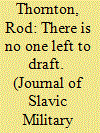

|
|
|
|
|
| Publication |
2013.
|
| Summary/Abstract |
Since the end of the Cold War, a succession of Russian government leaders has tried to abolish conscription. But ending Russia's conscript military and replacing it with one manned by professionals has not proven to be an easy task. In fact, it has proven impossible. It appears now, and especially after the recent removal of Defense Minister Anatoliy Serdyukov, that conscription will remain for the foreseeable future. Moreover, the attempts that the politicians have made to end conscription have left, in particular, the Russian army marooned between two manning schema: not quite professional and not quite conscript. This current arrangement is both strategically unsound and politically unsustainable.
|
|
|
|
|
|
|
|
|
|
|
|
|
|
|
|
| 8 |
ID:
123227


|
|
|
|
|
| Publication |
2013.
|
| Summary/Abstract |
The history of the Red Army in the Civil War of 1918-1922, in its significant part, was a history of mass treason and desertion of thousands of former officers (military specialists). Among them there were hundreds of General Staff specialists, the real representatives of Soviet military elite, whose treason was extremely dangerous for the fate of Soviet Russia. The treasons were both individual and group when the whole Soviet staffs fled to the Whites. Among the defectors there were representatives of almost all staff and command levels including several army commanders. These specialists of high qualification with academic background were aware of Soviet war plans, mobilization questions, and other classified data and could issue harmful orders before their defection to the enemy and influence the situation on the front. This article describes the reasons, history, circumstances, and results of this process that remained widespread until the decisive victories of the Reds in 1920. According to the calculations by Andrey Ganin, based on the vast, previously unknown data from Russian archives, almost every third General Staff specialist deserted the Red Army during that war. In spite of this, Bolsheviks managed to unite the experience of the military professionals with the new administrative methods and 'with iron and blood' organized powerful and effective military force which finally gained victory in the Civil War.
|
|
|
|
|
|
|
|
|
|
|
|
|
|
|
|
|
|
|
|
|